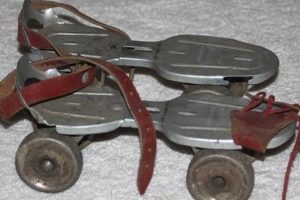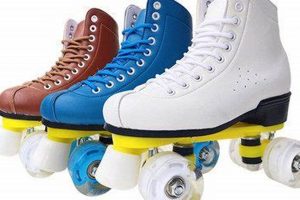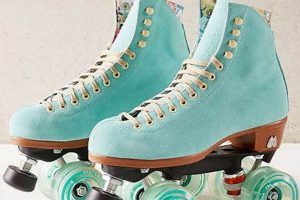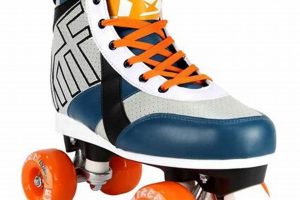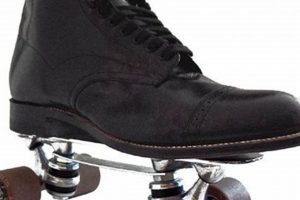These specialized recreational footwear items are designed for the fast-paced, full-contact sport of roller derby. They consist of a boot, typically made of leather or synthetic materials, mounted to a chassis (or plate) with four wheels arranged in a quad formation. An example includes equipment customized with low-cut boots for increased agility and maneuverability.
The equipment’s significance lies in its crucial role in allowing athletes to effectively participate in this dynamic sport. The design facilitates quick acceleration, sharp turns, and stable stops, all essential for competitive play. Historically, evolving models have adapted to meet the increasing demands of roller derby, incorporating advancements in wheel technology, plate construction, and boot design to enhance performance and safety.
Understanding the components and characteristics of these items is essential for selecting the appropriate gear. Furthermore, knowledge of maintenance procedures contributes to extending the life and performance of the equipment. The following sections will delve into these topics in greater detail, exploring aspects such as wheel types, boot construction, plate materials, and routine maintenance.
Essential Guidance for Roller Derby Equipment
Optimal performance and longevity of roller derby equipment depend on careful selection, proper maintenance, and informed use. The following guidelines offer a foundation for maximizing the potential of this specialized gear.
Tip 1: Wheel Selection: Wheel durometer, or hardness, directly impacts grip and roll. Softer wheels offer increased grip on slick surfaces, while harder wheels provide faster roll on smoother tracks. Select wheel durometer based on the track surface and skating style.
Tip 2: Boot Fit: A snug, secure fit is essential for control and injury prevention. The boot should offer adequate ankle support without restricting movement. Consider heat-moldable options for a customized fit.
Tip 3: Plate Material: Plate material affects responsiveness and durability. Aluminum plates offer a balance of strength and weight, while nylon plates are more flexible and cost-effective. Choose a plate material that aligns with skating style and budget.
Tip 4: Bearing Maintenance: Regular cleaning and lubrication of bearings are crucial for smooth roll and extended lifespan. Use a bearing cleaning kit and appropriate lubricant to maintain optimal performance.
Tip 5: Toe Stop Adjustment: Toe stop height and angle influence braking power and stability. Adjust the toe stops to a position that allows for comfortable and controlled stops.
Tip 6: Protective Gear Integration: Integrating comprehensive protective gear such as helmets, mouthguards, elbow pads, wrist guards and knee pads will provide safety measures.
Tip 7: Regular Inspection: Conduct routine inspections of all components, including wheels, bearings, plates, and boots, for wear and tear. Replace worn or damaged parts promptly to maintain safety and performance.
Adhering to these guidelines will contribute to enhanced performance, extended equipment lifespan, and improved safety during roller derby activities.
The final section will provide a summary of these key points, offering a comprehensive understanding of best practices related to roller derby equipment.
1. Boot Stiffness
Boot stiffness in roller derby equipment is a critical factor influencing performance, responsiveness, and energy transfer. The degree of rigidity in the boot significantly impacts a skater’s ability to execute precise movements and maintain stability during gameplay. This section outlines several key aspects of boot stiffness.
- Energy Transfer Efficiency
Stiffer boots minimize energy loss between the skater’s foot and the skate plate. This increased efficiency allows for more powerful strides and quicker acceleration. For instance, a boot constructed with a carbon fiber shell will exhibit greater stiffness compared to a traditional leather boot, resulting in improved energy transfer during explosive movements such as starts and jumps.
- Ankle Support and Stability
The level of ankle support provided by a stiff boot contributes directly to stability, particularly during lateral movements and sudden changes in direction. Adequate ankle support reduces the risk of ankle sprains and other injuries common in the sport. Boots designed with reinforced ankle padding and rigid exoskeletal structures enhance stability during high-impact maneuvers.
- Responsiveness and Control
Stiffer boots provide a more direct connection between the skater’s foot and the skate, leading to enhanced responsiveness and control. This is crucial for executing precise maneuvers, such as tight turns and controlled stops. A skater wearing a boot with a high stiffness rating will experience more immediate feedback from the skate, allowing for greater precision in their movements.
- Fatigue Reduction
While softer boots may offer increased comfort, stiffer boots can reduce fatigue by providing superior support and minimizing foot and ankle strain. By maintaining a more stable foot position within the boot, the skater expends less energy compensating for lateral movement and instability. This can be particularly beneficial during longer games or training sessions.
In conclusion, boot stiffness significantly affects performance characteristics by improving energy transfer, enhancing stability, boosting responsiveness, and potentially reducing fatigue. The optimal degree of stiffness depends on individual skating style and preferences, but it is an essential factor to consider when selecting appropriate equipment for roller derby.
2. Wheel Durometer
Wheel durometer, measured on the Shore A scale, denotes the hardness of a roller derby skate wheel. This characteristic profoundly influences grip, roll speed, and overall performance. Lower durometer values (e.g., 78A-88A) indicate softer wheels, providing enhanced grip, especially on slick surfaces. The increased friction between the wheel and the track translates to more controlled movements, which is advantageous for newer skaters or those prioritizing maneuverability. Conversely, higher durometer values (e.g., 92A-101A) represent harder wheels, facilitating faster roll speeds. Harder wheels minimize contact area with the track, reducing friction and enabling quicker acceleration and sustained momentum. The selection of wheel durometer is thus a critical decision point, affecting a skater’s agility, speed, and control.
The significance of wheel durometer extends to strategic gameplay. Skaters often adjust wheel hardness based on track conditions and their specific role. For example, a jammer, requiring rapid bursts of speed to break through the pack, might opt for harder wheels to maximize roll. Conversely, a blocker, focusing on maintaining position and executing strategic stops, might choose softer wheels for superior grip and stability. Furthermore, the interplay between wheel durometer and wheel profile (shape) contributes to overall handling. A narrower profile, often paired with a harder durometer, further reduces friction, while a wider profile, combined with a softer durometer, increases contact area for enhanced grip.
Selecting an appropriate wheel durometer is essential for optimizing the performance of derby roller skates. While harder wheels offer speed advantages, softer wheels provide improved grip and control. Skaters should carefully consider track conditions, personal skating style, and their role within the team when making this critical equipment choice. Improper selection can result in reduced agility, decreased speed, or even increased risk of falls, underscoring the practical significance of understanding and applying the principles of wheel durometer within the context of roller derby.
3. Plate Material
The plate, a critical component connecting the boot to the wheels on derby roller skates, significantly influences the skate’s responsiveness, durability, and overall performance. The selection of plate material directly affects how forces are transferred from the skater’s body to the wheels, impacting maneuverability and speed. Inadequate material selection can lead to plate failure under the rigorous demands of roller derby, whereas optimal material choice enhances an athlete’s control and power. For instance, a novice skater using skates with a flexible nylon plate might find it more forgiving for initial learning, but an experienced skater will quickly identify the limitations in energy transfer and responsiveness compared to a stiffer aluminum or composite plate. The material properties, therefore, directly dictate the skate’s suitability for different skill levels and playing styles.
Aluminum plates, commonly used in mid-to-high-end derby roller skates, provide a balance of strength, weight, and cost. Different grades of aluminum alloys offer varying degrees of stiffness and impact resistance. Some manufacturers employ aircraft-grade aluminum to maximize durability and minimize weight. Composite plates, often made from reinforced polymers or carbon fiber, offer lightweight and customizable stiffness profiles. They can be engineered to provide specific flex characteristics, catering to particular skating techniques or preferences. For example, a skater preferring agile turns might benefit from a plate designed with strategically placed flex points, while one emphasizing straight-line speed might opt for a stiffer plate for improved power transfer. The mounting system whether it’s a standard bolt-on or a more advanced direct-mount configuration also impacts the effectiveness of the chosen material.
Understanding the properties of different plate materials and their implications for skate performance is essential for skaters to make informed equipment choices. The plate’s durability is paramount, considering the intense impacts sustained during gameplay. Selecting a plate appropriate for one’s skill level, skating style, and budget is crucial for optimizing performance and ensuring safety. Ongoing research into new materials and manufacturing techniques continually pushes the boundaries of what’s possible in skate plate design, contributing to advancements in skater performance and equipment longevity. Ultimately, the plate material serves as a foundational element in the overall design and functionality of derby roller skates, impacting virtually every aspect of a skater’s experience.
4. Bearing Precision
Bearing precision, quantified using the Annular Bearing Engineers’ Committee (ABEC) scale (ranging from ABEC 1 to ABEC 9, with higher numbers indicating tighter tolerances) or ISO equivalent, directly influences the performance of derby roller skates. The bearings facilitate wheel rotation, and their precision dictates the smoothness and efficiency of this movement. Higher precision bearings exhibit reduced internal friction, enabling faster roll speeds and requiring less effort from the skater to maintain momentum. Conversely, lower precision bearings introduce greater friction, leading to slower speeds and increased energy expenditure. This difference manifests tangibly during gameplay; skaters equipped with high-precision bearings often demonstrate improved acceleration and sustained velocity, offering a competitive advantage. The selection of appropriate bearing precision is thus a critical factor in optimizing skate performance.
Practical implications of bearing precision extend beyond mere speed. Tighter tolerances in high-precision bearings reduce wheel wobble, enhancing stability and control, especially during quick turns and abrupt stops. This translates to improved maneuverability and reduced risk of falls, crucial for navigating the tight confines of the roller derby track. However, higher precision bearings typically require more frequent cleaning and maintenance to sustain optimal performance. Even minute amounts of dirt or debris can compromise their performance and reduce their lifespan. By contrast, lower precision bearings are more tolerant of contamination and may require less frequent maintenance. The choice between higher and lower precision, therefore, involves a trade-off between performance, maintenance requirements, and cost.
The relationship between bearing precision and derby roller skates is multifaceted, influencing speed, stability, maintenance demands, and cost. While high-precision bearings offer potential performance advantages, their benefits are contingent on proper maintenance and a skater’s ability to capitalize on enhanced responsiveness. Skaters must weigh these factors carefully, considering their skating style, budget, and commitment to maintenance, to select bearings that best suit their individual needs and enhance their performance on the track. Improper selection can result in suboptimal performance or unnecessary expense, highlighting the importance of understanding this critical component.
5. Toe stop adjustability
Toe stop adjustability in roller derby skates is a crucial factor directly influencing braking efficiency, agility, and overall skater control. The toe stops, located at the front of the skate plate, serve as primary braking mechanisms and pivotal points for various maneuvers. The capacity to adjust their height and, in some models, their angle, allows skaters to customize their skates to their individual skating style, body mechanics, and the specific demands of different track surfaces. The practical effect of this adjustability is readily apparent: a skater who prefers a low toe stop position achieves quicker stops and more precise directional changes, which is critical for jammers navigating through the pack. Conversely, a blocker might favor a higher toe stop position to facilitate more stable and controlled stance during defensive maneuvers. Therefore, toe stop adjustability is more than a convenience; it is a functional necessity that directly impacts a skater’s effectiveness and safety.
Furthermore, the adjustability of toe stops mitigates the effects of wear and tear. As toe stops are repeatedly used for braking and pivoting, they gradually wear down. Adjusting the height of the toe stop allows skaters to maintain a consistent distance between the toe stop and the skating surface, compensating for the material lost through abrasion. This ensures consistent braking performance and extends the usable lifespan of the toe stops. Failure to maintain appropriate toe stop height can lead to inconsistent braking, unstable balance, and an increased risk of falls. For example, if the toe stops wear down significantly without adjustment, the skater may need to lean further forward to achieve adequate braking force, compromising their balance and increasing the time required to come to a complete stop. This delay can be critical in avoiding collisions with other skaters.
In summary, toe stop adjustability provides critical advantages in braking control, agility, and safety. It allows for personalized skate setup, compensates for wear, and ultimately enables skaters to optimize their performance on the track. The absence of this feature limits a skater’s ability to adapt their equipment to their specific needs and reduces their overall control and maneuverability. Recognizing the practical significance of toe stop adjustability is essential for both novice and experienced skaters seeking to enhance their performance and safety in roller derby.
6. Truck Tightness
Truck tightness, referring to the adjustment of the kingpin nut on derby roller skates, exerts a substantial influence on maneuverability and stability. This adjustment modifies the resistance to turning, impacting how easily the skates respond to weight shifts and directional changes. The effect is pronounced in the context of roller derby, where rapid pivoting, tight turns, and quick stops are integral to gameplay.
- Turning Radius and Agility
Looser trucks facilitate a smaller turning radius, enabling quicker, more agile movements. Skaters may opt for looser trucks when navigating through dense formations of opponents, requiring rapid directional changes. Overly loose trucks, however, may compromise stability, particularly at higher speeds. As an example, a jammer attempting to evade blockers in close quarters might benefit from looser trucks, while a blocker focusing on maintaining a stable defensive stance would likely prefer tighter trucks.
- Stability and Control
Tighter trucks increase stability and control, particularly at higher speeds. This setup reduces the likelihood of unwanted wheel wobble and provides a more predictable response to directional inputs. Skaters often prefer tighter trucks when engaging in straight-line speed or executing powerful pushes. As an example, a skater accelerating out of a turn might benefit from tighter trucks to maintain a stable trajectory and maximize power transfer.
- Impact Absorption and Energy Transfer
Truck tightness affects the skate’s ability to absorb impact and transfer energy. Looser trucks can absorb more impact, reducing stress on the skater’s joints and improving comfort, but may also diminish energy transfer. Tighter trucks provide a more direct connection to the wheels, enhancing energy transfer for more powerful strides and quicker acceleration. The specific choice depends on skating style and the skater’s tolerance for impact.
- Customization and Personal Preference
Optimal truck tightness is highly individualized, dependent on skating style, body weight, and personal preference. Experimentation is essential to find the setting that provides the best balance of maneuverability and stability for each skater. Adjusting truck tightness is a routine aspect of skate maintenance and preparation, allowing skaters to fine-tune their equipment to suit specific track conditions and gameplay strategies. A beginning skater may prefer a tighter truck to start to build confidence and stability.
In conclusion, truck tightness functions as a critical parameter influencing the handling characteristics of derby roller skates. Precise adjustment allows skaters to optimize their equipment for specific gameplay demands, enhancing both agility and stability. The relationship between truck tightness and skater performance underscores the importance of understanding and customizing this element for competitive success in roller derby.
7. Durability
Durability, as applied to roller derby skates, represents the capacity of the equipment to withstand the intense stresses and impacts inherent in the sport. This attribute is paramount due to the physical nature of roller derby, where skates are subjected to frequent collisions, abrupt stops, and rapid directional changes. Therefore, a skate’s durability directly translates to its longevity, reliability, and, critically, the skater’s safety and performance.
- Boot Construction and Materials
The materials and construction techniques used in the skate boot significantly contribute to its overall durability. Boots constructed from high-quality leather or reinforced synthetic materials, coupled with robust stitching and impact-resistant reinforcements in key areas, such as the toe and ankle, are better equipped to withstand the forces encountered during gameplay. For example, a boot constructed with multiple layers of abrasion-resistant material provides superior protection against wear from frequent contact with the track surface and other skaters, compared to a boot made with thinner, less durable materials.
- Plate Strength and Composition
The skate plate, which connects the boot to the wheels, is another critical determinant of durability. Plates constructed from high-strength aluminum alloys or composite materials offer superior resistance to bending and cracking under stress. The design and manufacturing process of the plate, including heat treatment and reinforcement techniques, also play a crucial role in its ability to withstand repeated impacts and heavy loads. A plate that exhibits excessive flex or is prone to cracking compromises the skate’s responsiveness and can lead to equipment failure, jeopardizing the skater’s safety.
- Wheel and Bearing Integrity
Wheel and bearing durability impacts the overall performance and lifespan of the skates. High-quality wheels made from durable urethane compounds resist wear and maintain their shape under pressure. Bearings constructed with hardened steel races and precision engineering provide smooth rolling and withstand the forces generated during rapid acceleration and deceleration. Inferior wheels and bearings may degrade quickly, leading to reduced speed, poor handling, and potential equipment failure. Regular maintenance and timely replacement of worn wheels and bearings are essential to preserving the skate’s performance and extending its lifespan.
- Hardware and Fastener Reliability
The durability of the hardware and fasteners used to assemble the skates, including bolts, nuts, and rivets, is often overlooked but crucial for ensuring the overall structural integrity of the equipment. High-quality hardware made from corrosion-resistant materials prevents loosening and breakage under stress. Regular inspection and tightening of fasteners are essential to maintaining the skate’s structural integrity and preventing components from separating during gameplay. Failure to address loose or damaged hardware can lead to equipment failure and potential injury.
In summary, the durability of derby roller skates is a multifaceted attribute encompassing the materials, construction, and maintenance of various components. It directly influences the skate’s longevity, performance, and the skater’s safety. Skaters should prioritize durability when selecting equipment, investing in high-quality skates built to withstand the rigorous demands of roller derby. Regular inspection and maintenance are crucial for maximizing the lifespan and performance of the skates, ensuring their continued reliability on the track.
Frequently Asked Questions About Derby Roller Skates
This section addresses common inquiries related to specialized footwear designed for roller derby, aiming to provide clear and concise information regarding their selection, use, and maintenance.
Question 1: What constitutes the key difference between derby roller skates and recreational roller skates?
Derby roller skates are engineered for the specific demands of roller derby. Key differences include: lower-cut boots for increased agility, more durable plate materials to withstand impacts, and specialized wheel durometers tailored for track surfaces. Recreational skates typically prioritize comfort and affordability over high performance and durability.
Question 2: What factors should influence the selection of wheel durometer?
Wheel durometer selection depends on track surface conditions and the skater’s role within the team. Softer wheels (lower durometer) offer increased grip on slick surfaces, beneficial for blockers. Harder wheels (higher durometer) provide faster roll on smoother surfaces, advantageous for jammers. Personal preference and skating style are also considerations.
Question 3: How frequently should bearings be cleaned and lubricated?
Bearing cleaning and lubrication frequency depend on usage intensity and environmental conditions. Skates used regularly in dusty environments require more frequent maintenance, approximately every 1-2 months. Skates used less frequently or in cleaner environments may require maintenance every 3-6 months. Reduced roll speed or increased noise indicates a need for immediate maintenance.
Question 4: What are the potential consequences of neglecting toe stop adjustments?
Neglecting toe stop adjustments can lead to inconsistent braking, reduced agility, and an increased risk of falls. Worn toe stops can alter braking distances and stability, compromising skater control. Regular inspection and adjustment are essential for maintaining consistent performance and preventing injuries.
Question 5: How does truck tightness impact skate performance?
Truck tightness significantly affects maneuverability and stability. Looser trucks facilitate tighter turns, while tighter trucks enhance stability at higher speeds. The optimal setting is dependent on individual skating style and preference. Experimentation is encouraged to determine the most suitable configuration.
Question 6: What are the key indicators of excessive wear requiring equipment replacement?
Indicators of wear necessitating equipment replacement include: cracks or deformities in the boot or plate, excessive wheel wear or delamination, bearing failure or significant friction, and stripped or damaged hardware. Continued use of worn equipment compromises safety and performance.
Proper understanding and application of this information will contribute to informed equipment decisions, enhanced performance, and improved safety during roller derby activities.
The subsequent section will delve into advanced customization options and strategies for optimizing roller derby skate performance.
Concluding Remarks on Derby Roller Skates
The preceding exploration has illuminated the multifaceted nature of derby roller skates, emphasizing the critical interplay between components like boot stiffness, wheel durometer, plate material, bearing precision, toe stop adjustability, truck tightness, and overall durability. Each element contributes uniquely to the equipment’s performance characteristics, influencing a skater’s agility, speed, stability, and safety on the track. Selecting appropriate equipment and understanding its maintenance demands are paramount for maximizing potential and minimizing risks.
The continuous advancement of materials and designs in this specific athletic equipment reflects an ongoing commitment to enhancing athletic performance and ensuring skater safety. Continued vigilance in monitoring equipment condition and adherence to proper maintenance protocols are essential for responsible participation in the sport. The ultimate success and safety of skaters depend on a comprehensive understanding of this equipment and a dedication to its careful management.


